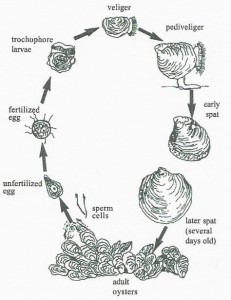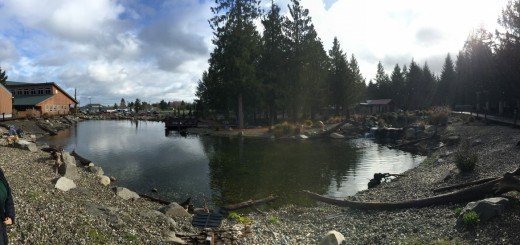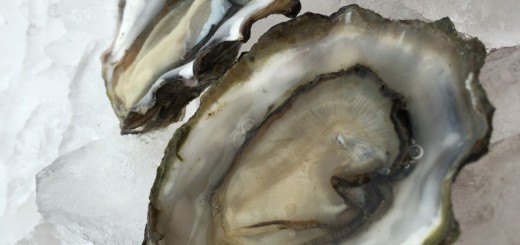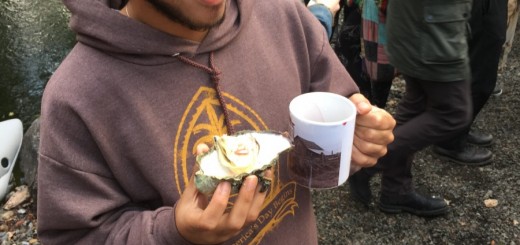Component 2: Natural History of Oysters
Crassostrea gigas, The Pacific Oyster
Life Cycle and Reproduction: The life of a Pacific Oyster may seem at first to be still, lifeless, stagnant. After studying where this tiny creature travels from, and finally to, to live out its life, we have found that he, the Pacific Oyster, actually lives quite a dynamic life.
First, a female releases millions of eggs at the same time that sperm is released from a male. Fertilization occurs externally in the salty ocean water. The young, fertilized larvae float along with plankton as a food source for nearly a month. They may drift as far as 240 kilometers in their larval stage. A Pacific Oyster larvae may attach itself to a ship and go to waters far, far away.
The oyster is called a spat at the stage when its body is about 3mm across and it is ready to attach to a surface. The oyster attaches itself with its left valve onto a solid substrate. He will never again be able to move at this point, but imagine all the sea life he witnesses if he lives for 2 decades or more. Over the course of his years his hard argonite and calcite shell forms as he feeds on the algae and food particles that pass through his gills.
The oyster will mature and usually grows to be a male at first within the first year. These hermaphroditic creatures will change sexes throughout their lifetime back and forth from male to female. This is usually based on prevalance of food. Once at sexual maturity at age one, the oyster then contributes back to the beginning of the life cycle, producing either sperm or egg, where the story happens all over again.
Native and Cultivated Geographic Ranges: These oysters can survive in a variety of ranges of temperature, salinity, oxygen levels, depth of water. From native waters of the Pacific Northwest, to both north as far as Alaska, and south as far as California. They have also been largely dispersed from Japanese waters. Cultivators made attempts to bring populations to German and Dutch waters, with firm successes in other areas like South Africa, Austraila, France and New Zealand.
Though they have a wide range of water conditions in which they can survive, pollution does present an extreme problem for their survival in the future. Rising acidity levels of the oceans in which they live have caused mortality rates to rise. Also, these animals retain toxins in their flesh, of which we end up consuming when we eat them.
Suitable Habitat (for entire life cycle):
Water quality parameters that suit the Pacific Oyster-
Temperature: 4-35°C, as low as -5°C, at least 20°C for reproduction
Salinity: 10-42psu, optimal between 23-36psu
Turbidity: high
Nutrients: bacteria, protozoa, wide variety of diatoms
Toxins/Pollutants): heavy metals like zinc and copper, herbicides, insecticides, and fungicides
Major Predators: Though the Pacific Oyster has an extremely tough shell to crack, it does have its enemies. Some crab species are oyster predators and would be happy to have them for dinner; these species are Metacarcinus magister, Cancer productus, and Metacarcinus gracilis. Starfish such as Pisater ochraceus, P. brevispinus, Evasterias troschelii and Pycnopodia helianthoides prey on the Pacific Oyster as well.
Parasites or Diseases: A number of diseases can occur from various viruses, bacterium, and protozoan parasites. A Canadian shellfish contamination board posts the following: “Eating shellfish with high levels of certain toxins can lead to serious or potentially fatal illnesses such as: Paralytic Shellfish Poisoning (PSP) (commonly known as Red Tide), Amnesic Shellfish Poisoning (ASP) and Diarrhetic Shellfish Poisoning (DSP).”
Additionally, Vibrio parahaemolyticus occurs as another disease amongst Pacific Oyster populations. It is a natural bacteria which, present in high concentrations, can lead to high toxicity for humans to eat.
Nursery Propagation Methods: When we visited the Taylor Shellfish Farm a few weeks ago we learned about the entire process of growing and harvesting oysters. One of the top shellfish farmers in the country, the family owned hatchery has been in the oyster practice for over 100 years.
The actual nursery is more like a science lab full of high tech equiment to keep things monitored and sterile. Records are taken to ensure and keep track of genetic crossover throughout oyster generations. Oysters that are triploidy are the most common oyster on the farm. These oysters do not reproduce, but instead they channel all of their energy into rapid and enlarged growth.
Both male and female oysters are nurtured in crates. When their sex has been determined and they are ready to begin spawning, a process whereby the water temperature is raised is used in order to induce egg formation. They release their gametes into the water to be fertilized externally.
Once the fertilized larvae are ready, they are mixed in huge, regulated tanks. These larvae swim and form their ciliated foot to move and also an eye. At this point in their life cycle, they are actively searching for site of attachment, to live forever. In the wild, rocks, other oysters, and more aforestated substrates serve as sites of attachment for young oyster larvae.
In the nursery setting however, and in the big tanks, a culch made of ground up oyster shells serve as attachment sites for the oyster larvae. Some of these oysters may also attach to one another.
In the next step, a screen mesh is used to separate the oysters by their size. Other shellfish are grown at hatcheries like the Taylor shellfish hatchery in Shelton; these include geoduck, clam, and mussel. Other trays of young shellfish are cultured in regulated tank areas also. Feeding tanks breed large quantities of algae for the oysters and other shellfish to eat.
The next step is to allow the oysters to be introduced into natural waters and for rapid growth. A feeding pump of algae thrusts food up to the oysters which are held on a compartmentalized raft. After just a few weeks, the tiny oyster larvae have grown to the size of a quarter and formed the beginnings of what will be their lifelong home in the form of a shell. These compartments are monitored and sorted based on growing patterns to keep like size among like sized oysters.
Eventually the oysters are harvested into crates for cleaning and storing! An extremely cold factory pushes through thousands of pounds of oysters each week to process them to sell to market.
Productivity of Oyster Industry: (eg. yield of oysters in specific areas or under specific conditions) Oysters in the Pacific Northwest have taken a backseat in productivity as ocean acidification levels rise cause by pollutive emissions in the environment. Over the last decade, oyster producers have noted over an 80% reduction in oyster crop yields.
Some areas are countering this problem by dropping millions of oysters shells in different bays to try to boost the populations there.These oysters are solely for the environment, however, in hopes that they filter the water sufficiently to bring health back to the surrounding waters.
Peak production of PNW oyster yields were at around 10 million pounds in the mid 1950s. These numbers dropped to 6.4 million up to 1970. These numbers have declined even more and in recent years have fluxuated between 8 and 11 million pounds.


![IMG_0074[1]](http://blogs.evergreen.edu/terroir-oyster4/files/2015/09/IMG_00741-300x225.jpg)




